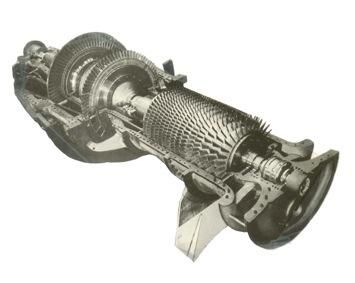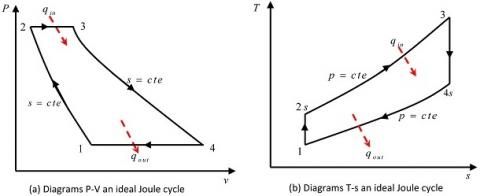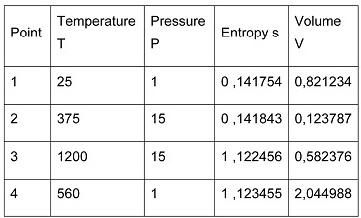Performance control of gas turbines
Gas turbine (GT) thermal efficiency is sensitive to ambient air temperature variations.
Take the case

of a GE MS 3002 in a gas compression station in Algeria. It is fueled by natural gas transported by pipeline from line that passes close to a pumping station. Control instrumentation is installed at the station to track the status of the machines and adjust pressure, temperature, volume and density.
Thermodynamic analysis indicated possible improvements are based on performance control of a gas turbine (GT). This may offer improvements over traditional methods by boosting thermal efficiency the net mechanical power output, thus reducing specific mass through the inter-channel turbine blades. Modeling was done using the GE MS 5002b GT. This highlighted the fact that performance is influenced by the temperature of the ambient air which varies seasonally.
GT plants can work with a constant pressure cycle (Brayton cycle or Joule) or with a constant volume cycle. Whereas; for the purposes of the theoretical analysis of the cycle, it is assumed that the GT power plant operates with a closed circuit.

Figure 1: The thermodynamic cycle of a GT
Figure 1 shows the conventional temperature - entropy (Ts) diagram of a thermodynamic cycle). Air is compressed in the compressor between position 1 and 2. Heat added to the combustion chamber carry back the cycle from position 2 to 3. Hot gas expands and the Brayton or Joule cycle has two processes, an isentropic process (adiabatic and reversible) and an isobaric process. The main variables are minimum temperature T1, maximum temperature T3 and the pressure ratio, or compression ratio .
In ideal Joule cycle processes: compression (1, 2) and expansion (3, 4) reproduce in the compressor and the turbine respectively, and they are supposed to be isentropic; added heat (2, 3) in the exchanger heat (combustion chamber) and rejection (4.1) occur at constant pressure. Some hypotheses are considered during this cycle as follows: pressure losses in the heat exchangers and the passages connecting the equipment are negligible; and the operation fluid is a perfect gas; the efficiency of heat exchangers is 100%.
The proposed temperature control system is designed to measure and control exhaust temperature rather than ignition temperature for practical reasons. However, indirect control of ignition temperature is accomplished based on known aerodynamic and thermodynamic characteristics of the GT.
Testing at the SC2 compression station at M'SEKA, Algeria included the calculation of compensated thermocouple readings, selection of the reference point for temperature control, calculating of the value of the control point as well as temperature and exhaust values. These were then compared to reference values to generate a fuel control signal to limit exhaust temperature. Figures 2 and 3 illustrate the temperature evolution (entropy (Ts)-(Pv)).

Figure 2: Obtained diagram entropy (Ts) of Brayton Cycle
Figure 3: Obtained diagrams Pv an ideal Joule cycle
In an open Brayton cycle, air is aspirated in at the compressor at position 1 equivalent to (25°C) to position 2 with a pressure of 1 bar and compressed to 15 bar. Heat added in the combustion chamber carries the cycle from position 2 to 3, which exits at a temperature of (1200°C). Table 1 summarizes the modeling steps.
Table 1: Data Modeling

Note that as compressor inlet temperature increases, the specific compression work increases while the air mass flow rate decreases due to a decrease in specific gravity). Accordingly, there is a decrease in turbine efficiency, useful work and power. If the temperature decreases, the reverse happens. If atmospheric pressure decreases relative to the reference pressure, the mass flow rate decreases and useful power is reduced proportionally.
If relative humidity increases, power output decreases and specific consumption (RH) increases. From the obtained results, therefore, it can be confirmed that there are other factors affecting turbine performance defined as "inner" factors, as they are related to ancillary systems. Thermodynamic calculations show that performance is influenced by the temperature of the ambient air which varies considerably with the seasons. The ideal Brayton cycle presents an approximation of the thermal processes. This concept can be used as a base of control, and analysis of real cycles deviating from the ideal model.
(Benrabeh Djaidir is a PhD doctoral student in automation system at the University of Djelfa in Algeria and member of Applied Automation and Diagnostics Industrial laboratory, holds a Masters in Industrial Instrumentation maintenance in 2012. B.djaidir@univ.djelfa.dz)
(Dr Ahmed Hafaifa is Senior Lecturer in Industrial Process Automation and Control Engineering at the Science and Technology Faculty of the University of Djelfa, Algeria. hafaifa.ahmed.dz@ieee.org)
(Dr Kouzou Abdellah (IEEE & IACSIT Senior member, IFAC, IAENG & IISRO member) is an associate professor with Djelfa University in Algeria and the president of the Scientific Council of the Sciences and Technology Faculty at the same university.kouzouabdellah@ieee.org)